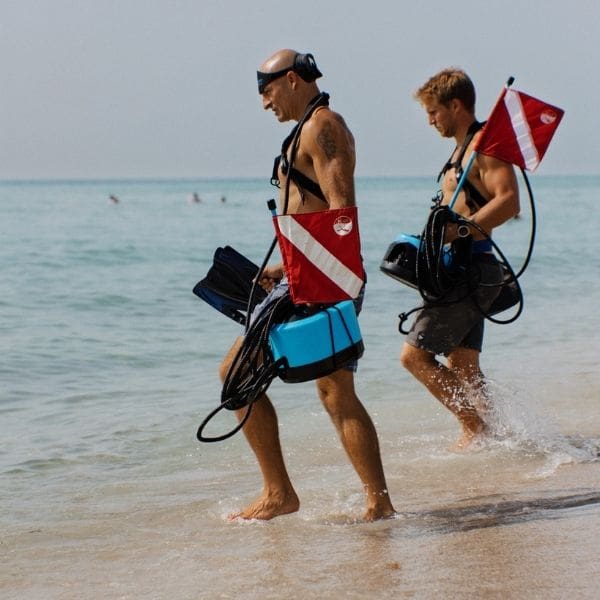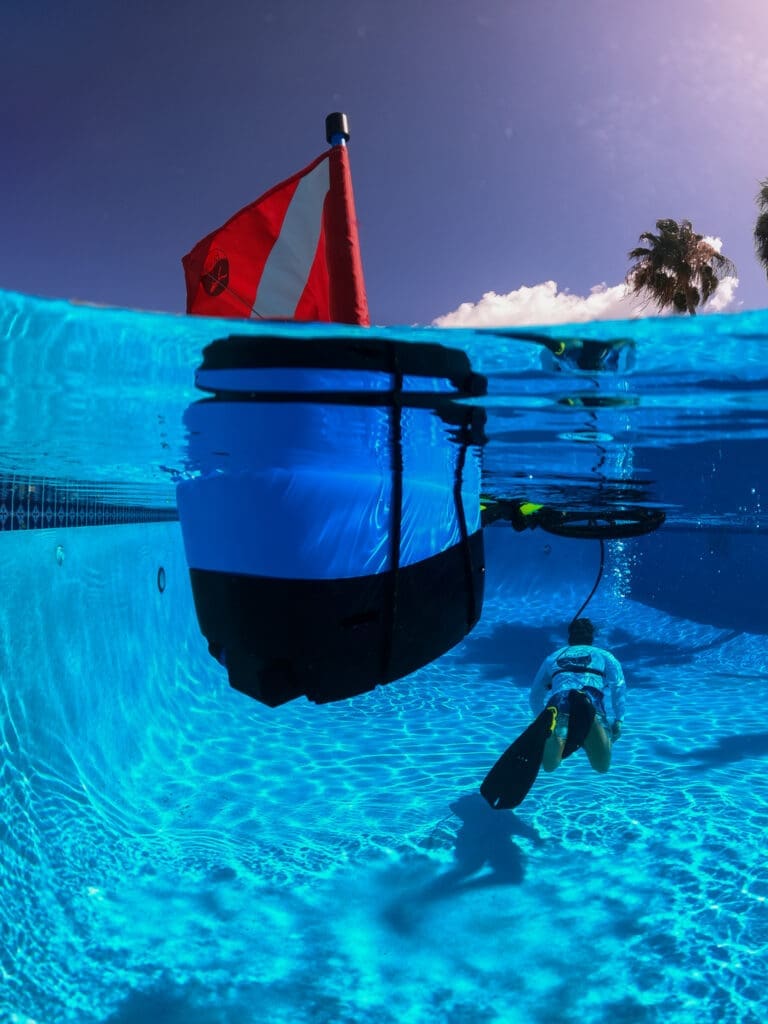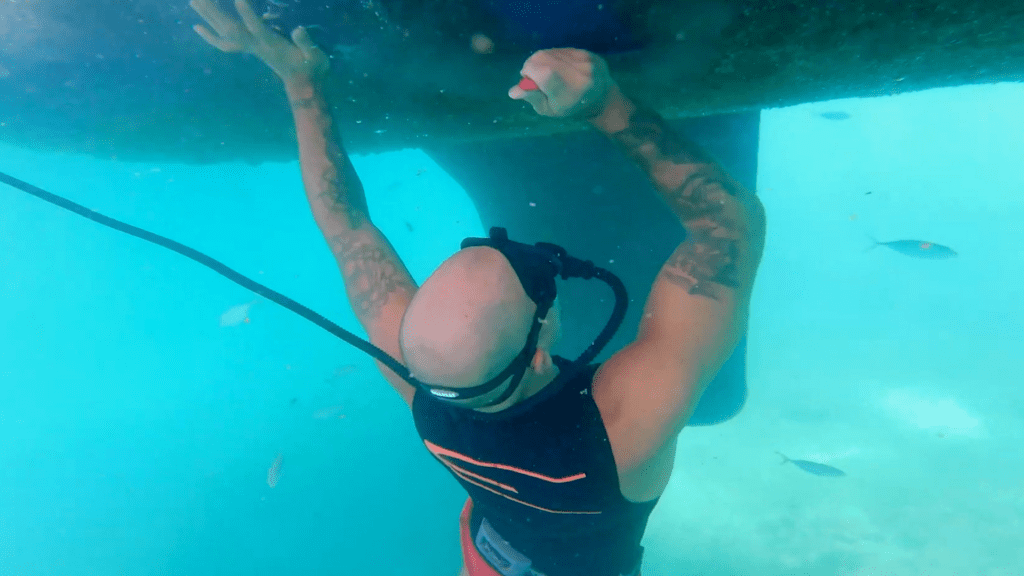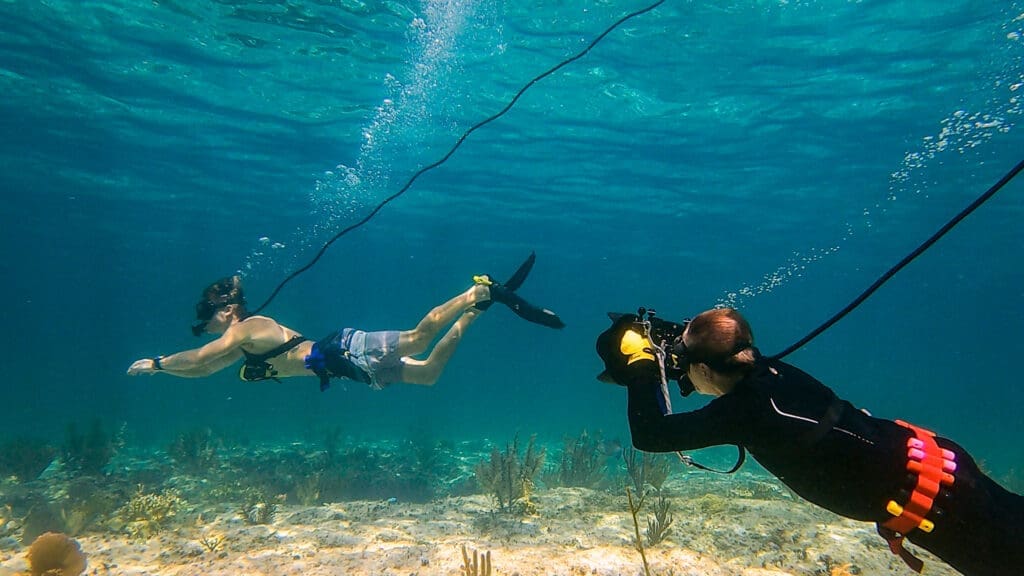
Snuba Diving Gear Unpacked: What It Is and the Coolest Modern Alternatives for Simpler, Tank-Free Dives
Exploring the underwater world without hauling heavy tanks has been a game-changer thanks to surface-supplied breathing systems. Often referred to as snuba diving gear, this type of setup delivers air from the surface through a hose, bridging the gap between snorkeling and scuba. Whether you’re just curious about snuba diving gear or you’re looking for equipment that offers a tank-free experience, getting the lowdown on how it works and what awesome tankless options are out there can seriously level up your underwater adventures. This piece breaks down what the different forms of diving are all about, the main parts, how we got from scuba to these slick tankless systems, introduces BLU3’s Nomad and Nomad Mini as the latest innovations, who’ll dig these systems the most, the must-knows on safety and getting certified, and where to find more info to keep the good times rolling.
What Exactly Is Snuba Diving and How Does Its Gear Function?
SNUBA® diving, offered by licensed operators, is often described as a hybrid of snorkeling and scuba, where you get your air from a float on the surface via a long hose. This lets you cruise down to about 20 feet without needing full scuba certification. It’s a surface-supplied breathing method that makes you way more mobile underwater and lowers the barrier for anyone wanting to see more without the weight of a tank.
What Are the Must-Have Components of Snuba Diving Gear?
To understand what people refer to as snuba diving gear, let’s look at how each piece helps you breathe underwater.
- A floaty raft that holds one or more air tanks.
- A regulator that dials down the tank pressure to a breathable level.
- A hose with multiple ports to send air to your mouthpiece.
- A mask and fins for seeing and moving around.
Every bit works together to deliver air, manage pressure, and keep you balanced, making shallow underwater exploration possible without tanks. SNUBA® itself is a registered brand that provides this style of surface-supplied diving through guided excursions, but many people now use “snuba gear” informally to describe similar systems. Checking out how these parts have evolved leads us to compare snuba with other surface-supplied setups.
How Does Snuba Compare to Scuba and Hookah Diving?
Scuba and snuba both use regulators, but scuba keeps the tank on your back, letting you go deeper than 60 feet. Snuba, with its raft-mounted air, caps you at around 20 feet. Traditional hookah diving uses bigger compressors on boats for endless air, but that means engine noise and power needs. Snuba, on the other hand, is way quieter and simpler to manage, perfect for eco-conscious exploring near reefs.
Snuba’s freedom to move like a freediver without heavy gear sets it apart from scuba. Plus, its smaller surface setup means less noise and fuel use compared to those old-school gas-guzzling hookah compressors.
What Are the Common Ways People Use Snuba Diving?
- Fun family outings to introduce the underwater world.
- Cruising shallow reefs to check out marine life.
- Snapping underwater photos of vibrant reefs.
- Awesome learning experiences for first-time divers.
These uses show how snuba balances accessibility and depth range, setting the stage for the slick, modern tankless systems we’ll talk about next.
How Have Underwater Breathing Systems Changed: From Scuba to Tankless Dive Systems?
Breathing underwater has come a long way, from bulky steel tanks to super portable surface-supplied compressors. Tankless dive systems are the latest leap forward. As battery and compressor tech got better, designers reimagined how to deliver air without all the heavy gear, giving recreational divers way more freedom and portability.
Evolution of Diving Systems
The journey of underwater breathing gear has been epic, moving from early scuba setups to today’s cutting-edge tankless diving tech. This evolution has been all about boosting diver freedom, safety, and ease of use, while also shrinking down the size and weight of the gear. Brownie’s Third Lung, a pioneer in surface-supplied air systems since 1969, offers robust options including both gasoline-powered and battery-powered multi-diver tankless systems. BLU3, founded in 2017, is a sister company to Brownie’s Third Lung, specifically developed to focus on ultra-portable systems, building upon decades of expertise.
This bit of history helps us appreciate the tech advancements in diving we’re diving into.
What Is Tankless Diving and How Does It Work?
Tankless diving uses a battery-powered compressor that floats on the surface. It sucks in air from around it and sends it through a hose and regulator setup. This means no onboard tanks are needed because the compressor just keeps making air as you need it. This system lets you dive longer, cuts down on gear weight, and is the foundation for creating super user-friendly devices.
What Are the Perks of Portable Dive Gear Over Old-School Equipment?
- Super light to carry: battery-powered units weigh less than 15 pounds.
- Easy to get ready: prepping for your dive is a breeze.
- Dive longer: swapping batteries is quick and simple, done on dry land.
- Great for travel: some batteries are small enough to bring on planes.
Benefits of Portable Dive Gear
Portable dive gear brings a bunch of cool advantages over the usual stuff, like being super light to haul, incredibly easy to set up, and letting you stay down longer with less gear (think small batteries instead of extra tanks!). These features just make diving better and way more accessible for everyday divers.
PADI, Open Water Diver Manual (2023)
This mention backs up the article’s points on why portable dive gear rocks.
How Do Hookah Diving Systems Stack Up Against Snuba and Tankless Options?
Traditional hookah systems use gas or electric compressors on boats to supply endless air, but they need power and make engine noise. Snuba uses tanks on floats, limiting your depth and how long you can stay down. Modern tankless alternatives grab the best of both worlds: air from the surface without the noisy engines or heavy tanks, delivering quiet, eco-friendly performance for shallow dives.
By mixing portability and being kind to the environment, tankless systems totally beat out old-school hookah rigs and are way more convenient than snuba floats.
Why Should You Pick BLU3’s Nomad and Nomad Mini as Your Go-To Modern Snuba Alternatives?

BLU3’s Nomad and Nomad Mini are revolutionizing surface-supplied diving with their compact, tankless compressors built for adventure and ease. They unlock totally new diving possibilities. These systems deliver air through smart regulators, let you dive down to 30 feet, and pack into backpacks for effortless transport.
What Makes the Nomad Portable Dive System So Special?
The BLU3 Nomad portable dive system packs in awesome battery and compressor tech to keep you diving for up to three hours on a single charge.
- Smart Regulator: Automatically adjusts air pressure based on how deep you are.
- High-Efficiency Compressor: Pulls in fresh air from the surface.
- Depth Rating of 30 Feet: Opens up tons of different underwater activities.
This combo of features means more flexibility and reliability for explorers like you.
How Does the Nomad Mini Make Diving Compact and Super Accessible?
The Nomad Mini compact diving solution lets you explore down to 15 feet for up to two hours (using the DiveBoost Kit with 3 batteries linked up) in a package that’s incredibly light, starting at just 12 pounds.
- Snap-in Battery Pack: Makes charging a total breeze.
- Included Backpack: Makes traveling a cinch.
- Foldable Float Design: Packs up small and is optional, as the Nomad Mini will float on its own.
- Battery Swaps: Takes 20 seconds or less, and each battery weighs just over a pound – way lighter than a scuba tank.
Its super-portable design makes spontaneous dives from beaches, kayaks, or small boats way more fun and hassle-free.
What Are the Main Differences Between Nomad and Standard Snuba Gear?
| System | Portability | Depth Capability | Setup Time | Power Source |
|---|---|---|---|---|
| Snuba Float | Clunky air tanks on a raft | Around 20 feet | 10–15 minutes | Compressed tanks |
| BLU3 Nomad | Backpack-sized compressor | Up to 30 feet | Under 4 minutes | Rechargeable battery |
| BLU3 Nomad Mini | Super-compact mini unit | Up to 15 feet | Under 4 minutes | Rechargeable battery |
Compared to snuba, Nomad systems offer better depth range and are way less bulky, meaning quicker setup and easier transport.
When Should You Grab the Nomad Instead of Scuba for Shallow Dives?
Go for the BLU3 Nomad when you want simplicity and portability for shallow dives under 30 feet. Its compact design makes switching gear super fast at resorts, on boats, and at remote beaches, ditching the bulk and weight of scuba tanks. For day trips with minimal crew and gear, Nomad streamlines everything while still performing like a champ. Forget filling tanks – just swap or charge batteries and keep diving.
The Nomad family’s modern take on breathing from the surface unlocks more spontaneous diving adventures.
Who Gets the Most Out of Tankless Diving Systems Like Nomad?
Tankless systems are perfect for recreational divers who love simplicity, boat owners who want air on demand, and underwater photographers looking for easy, no-fuss platforms. The versatility of portable compressors makes diving more accessible and encourages wider exploration of the marine world.
How Do Boat Owners Benefit from Portable Dive Gear?
- No heavy tank inventory to store.
- Quick setup means you can do multiple dives a day.
- Compact design frees up valuable deck space.
- Quiet compressors keep the onboard vibe chill.
These perks enhance boating trips while reducing the hassle of complicated logistics.

Why Are Underwater Photographers Opting for Tankless Dive Systems?
Underwater photographers already juggle a ton of gear, so any simplification of the load is a huge win. This freedom lets them capture better shots and get more creative angles without wrestling with bulky tank changes.
Tankless technology directly supports smoother underwater photography workflows.

What Makes Tankless Diving Perfect for Recreational Snorkelers?
Recreational snorkelers can now go beyond just surface views and explore shallow dives down to 15 feet with tankless gear. The free training and instruction manual provide essential knowledge for using the system responsibly, encouraging more frequent and adventurous dips below the waves. BLU3’s goal is to deepen people’s connection to the underwater world and inspire them to protect it.
Making gear handling simple turns casual snorkelers into stoked divers ready to explore reefs and shipwrecks.
What Are the Essential Safety Tips and Certification Requirements for Tankless Diving?
Using tankless dive systems involves understanding proper operation, checking your gear, and adhering to depth limits. Completing the provided training ensures divers understand pressure management, ascent rates, and emergency procedures before using surface-supplied compressors.
How Does BLU3 Training Ensure Tankless Dive Systems Are Used Correctly?
BLU3 training mixes online learning with hands-on sessions you can do yourself in a pool or similar calm water. Divers learn how to manage airflow, emergency shutdown procedures, and the best ways to care for the environment. This combined approach ensures you are proficient with Nomad systems before hitting open water. BLU3 always suggests taking your training further with in-person instruction or scuba certification.
Comprehensive training bridges technical know-how with practical skills for enjoyable dives.
What Are the Key Safety Practices for Using Portable Breathing Apparatus?
The primary rule is to never hold your breath while diving – always breathe naturally, always inhaling or exhaling and NEVER holding your breath. Divers should always check hoses and regulators, perform pre-dive air-flow tests, monitor battery levels, and confirm depth limits. Maintaining neutral buoyancy with appropriate weights and ascending at a controlled pace reduces the likelihood of problems.
These precautions help ensure the diver’s experience and protect the ocean’s delicate ecosystems by minimizing gear malfunctions and potential habitat damage.
Do You Need Certification to Use Nomad or Other Tankless Systems?
All users must complete the BLU3 Online Dive Training Course before using any BLU3 dive systems. SCUBA certification is always a beneficial addition. While it’s not as extensive as open-water scuba credentials, the BLU3 training course covers essential diving principles, fundamental skills, and more.
Completing the training establishes a foundation of knowledge and aligns with recommended practices for recreational diving.
What Are the Best Resources to Dive Deeper into Snuba and Tankless Diving Equipment?
To really get into snuba and tankless systems, you’ll want detailed comparisons, operational guides, and expert advice. Reliable resources will help you make informed gear choices and dive responsibly.
Where Can You Find Detailed Nomad vs. Snuba Comparison Guides?
Check out our in-depth Nomad versus Snuba diving comparison to see how portability, depth, setup, and cost stack up. This guide shows how tankless compressors offer advantages over traditional floats when it comes to mobility and environmental impact.
Get the full scoop on BLU3’s comparison hub to figure out the best gear for your next underwater adventure.
How to Access BLU3 Dive Safety Guidelines and Training Programs?
BLU3’s website is packed with information including warnings, a free training course, and user manuals. Head over to the BLU3 Training page to sign up for theory and practice skills and drills at your own pace.
Engaging with these official resources will help you dive with competence and skill.
What FAQs Tackle Common Questions About Snuba and Tankless Diving?
Our FAQ section covers everything from depth capabilities and maintenance routines to training requirements and best practices for surface-supplied diving systems. By answering typical user questions—from managing airflow to being a good steward of the environment—these answers provide clarity for both new and experienced divers.
Consult these FAQs to clear up any doubts before your next dive.
Diving with modern portable systems like BLU3’s Nomad and Nomad Mini takes underwater exploration to the next level by ditching bulky tanks, simplifying setup, and opening up new diving possibilities. With the right training, gear checks, and by following depth guidelines, tankless dive gear allows divers to experience shallow reefs without heavy tanks – inviting more adventurers to support ocean conservation through responsible exploration. Ready to change up your next dive? Explore BLU3’s Nomad and Nomad Mini portable dive systems today.
SNUBA® is a registered trademark of Snuba International, Inc. BLU3 is not affiliated with Snuba International, Inc.